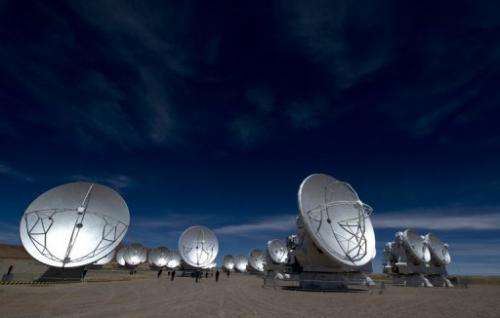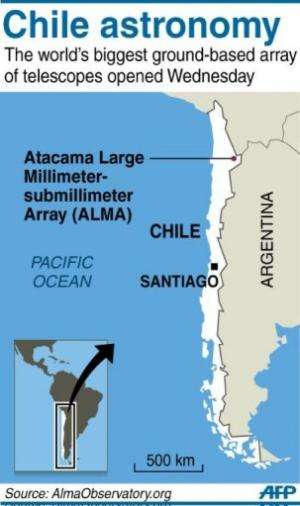View of a radio telescope antennas of the ALMA (Atacama Large Millimeter-submillimeter Array) project, in the Chajnantor plateau, Atacama desert, some 1500 km north of Santiago, pictured on March 12, 2013. The ALMA, an international partnership project of Europe, North America and East Asia with the cooperation of Chile, is presently the largest astronomical project in the world.
In a super-arid desert at an altitude of 5,000 meters, with almost no humidity or vegetation, the world's largest ground-based astronomy project opens for business on Wednesday ready to probe the universe with unprecedented might.
"What is so very special about this place is that, right here above our heads, there is virtually no water vapor. There is just so little that whatever light is emitted from a heavenly body, galaxy or star, it gets here with no interference" explained Gianni Marconi, an astronomer with the Atacama Large Millimeter-submillimeter Array, better known as ALMA (Spanish for "soul").
"And this is the largest observatory that has ever been built," Marconi underscored proudly.
Graphic locating Chile's Atacama Large Millimeter-submillimeter Array, the world's biggest ground array of telescopes, which opened on Wednesday.
ALMA is a joint effort among North American, European and Asian agencies. And when scientists went looking for a place to put this world's biggest ground array of telescopes, they looked for a spot that was high altitude, low humidity, sunny and boasting fairly easy logistical access.
Here at Llano Chajnantor, on a plain on a mountain near Chile's border with Bolivia, and near the tourist town of San Pedro de Atacama, they got what they were looking for and then some.
When scientists tested for humidity with ultrasensitive equipment, they at first thought it had broken because they could not believe how low the humidity was.
As there is virtually no humidity to get in the way, the ALMA's 66 antennas, ranging in diameter from seven to 12 meters, can glimpse at things in the darkest and remotest regions of the universe.
A scientist works at the radio telescope control station of the ALMA (Atacama Large Millimeter-submillimeter Array) project, in the Chajnantor plateau, Atacama desert, some 1500 km north of Santiago, on March 12, 2013. The ALMA, an int'l partnership project between Europe, North America and East Asia, with the cooperation of Chile, is presently the largest astronomical project in the world.
"The scientific community wants to use ALMA in its research on star formation, the birth of planets and not just what is happening in our solar system, but also on how the system was created after the Big Bang", ALMA director Thijs de Graaw told AFP.
He added: "It is a revolution in the history of the universe in the realm of millimetric and sub-millimetric waves, which can look through clouds of dust and focus on the formation of stars themselves. Telescopes cannot see what is happening inside these clouds. With ALMA, we can. And that is like opening a new window."
(c) 2013 AFP

























